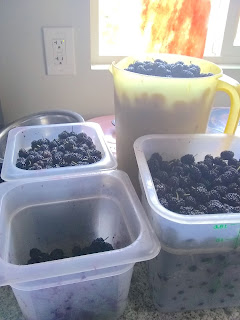For many of us, winter brings holiday opportunities to celebrate with, spend time with, and show gratitude for family and friends. I get immense joy from sharing with those I love food made with care and love from beautiful, wholesome ingredients. So with that in mind, I have spent the last year putting up foods to give as gifts or to share at gatherings.
Homemade pickled vegetables make beautiful hors d’oeuvres.
Hot sauce & salsas get rave reviews as gifts and are quickly consumed at parties.
Jams, preserves, compotes are very versatile: add to a cheese plate, serve with fresh baked rolls, bake on brie wrapped in puff pastry, spread on sandwiches, or in desserts. Make an unconventional version of a traditional holiday dessert,
trifle, by layering
cranberry compote with small chucks of
ginger spice cake, topped with a few spoonfuls of whipped heavy cream sweetened with maple syrup, and topped with a few pieces of toasted pecans. The cake and compote can be made a few days ahead of time, and assembled (up to 24 hours ahead of time) in small clear glass cups or mason jars for beautiful individual servings.
By preserving the harvest, we can share and enjoy the best each season has to offer year round. Our (or our neighbors’) trees & gardens can produce boatloads of produce, sometimes falling to the ground faster than we can pick it. Or ask your farmers or produce department if they have any overripe and pick up multiple pounds of the stuff at a lower price. Canning is not hard and what an awesome way to use fallen fruit and bruised veggies!
For the uninitiated, the canning process may seem intimidating to take on by one’s self. But it's ever-so-fun in a group, or find a friend with some experience, or follow instructions on the pectin package (or online or a book from the library). You will need some equipment: large pot, canning rack that will fit into said pot, canning jars (can be reused), new lids (these can't be heated twice), bands (can be reused), maybe a few other useful tools (like a ladel, funnel, spatula, maybe a magnet lid wand). Yes, it's a bit labor intensive but the results are pretty amazing and cheap, and all your loved ones will feel so fortunate if they get some.
In season now, persimmons and pomegranates are beautiful winter fruits that can be a little tricky:
You generally find two varieties of persimmon at the markets: fuyu (short, squatty shape) and hachiya (more oblong, teardrop shape). The fuyu you can eat firm and are a bit sweeter when they are just a bit soft). I do not recommend eating hachiya until it is very, very ripe, super soft, and jelly-like, almost translucent. If it's not, the hachiya is very astringent, which is not pleasant (but you may want to try it just for the experience).
Easily remove the jewel-like seeds of the pomegranate by scoring the outside with a knife, peel it apart and loosen the seeds from the pith in a bowl underwater. The seeds sink and the skin and pith float. Or try cutting it in half, and banging the outside with a wooden spoon over a bowl and the seeds fall out.
Another seasonal favorite, cranberries are not grown locally, but this compote is so much better than the jelled substance from a tin can. This is a new, easy recipe I improvised this year. Make it with love!
Honey Kumquat Cranberry Compote1 cup fresh orange juice from the farmers market
1 1/2 cups kumquats, sliced thin, seeds removed, from my backyard
3 cups fresh cranberries from the local co-op
1/2 cup local honey
Stir together all ingredients in a large saucepan over medium-high heat. Stir in the rest of the ingredients. Cover pan and bring to boil over high heat. Stir, reduce heat to medium, and cook covered for 5 minutes, until all cranberries burst. Uncover, reduce heat to simmer for 10 minutes, until thick.
Can be made weeks ahead of time (keep refrigerated) or canned:
Boil empty canning jars for 10 minutes and left them to sit in the hot water. In a separate small pot, soften lids in hot water (not boiling). Ladle hot compote into sterilized canning jars, filling ½ inch from the top, wipe off the rim with a clean damp cloth. Seal each jar with a lid and barely tighten bands. Boil jars for 15 minutes on a canning rack. Remove from water bath and let sit, undisturbed overnight. Test lids in the morning by pressing top to make sure they’re sealed; tighten bands and label your homemade gifts.


















